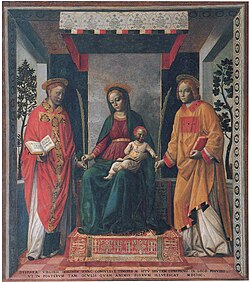Faustinus and Jovita
Saints Jovita and Faustinus | |
|---|---|
 Virgin Mary and Christ Child with Saints Jovita and Faustinus, by Vincenzo Foppa. | |
| Martyrs | |
| Born | Brescia |
| Died | 120 AD Brescia |
| Venerated in | Roman Catholic Church |
| Major shrine | Relics at Rome, Bologna, Verona, Brescia |
| Feast | February 15 |
| Attributes | depicted as two knightly brothers holding the palms of martyrdom. Sometimes only Jovita is shown, richly dressed and on horseback; an angel may be shown saving them from drowning; sometimes shown with Faustinus of Brescia |
| Patronage | Brescia |
Saints Jovita and Faustinus were said to be Christian martyrs under Hadrian. Their traditional date of death is 120. They are patron saints of Brescia.
"Jovita" in modern times is a woman's name. In some accounts the saints were instead Jovinus and Faustinus, brothers.
Traditional vita
Tradition states that they were members of a noble family of Brescia in Lombardy (northern Italy). Jovinus, the older brother, was a preacher; Faustinus, a deacon. For their fearless preaching of the Gospel, they were arraigned before the Roman Emperor Hadrian, who at Brescia, Rome and Naples, subjected them to frightful torments, after which they were beheaded at Brescia in the year 120, according to the Bollandists, though Allard (Histoire des Persécutions pendant les Deux Premiers Siècles, Paris, 1885) places the date as early as 118.
Saint Faustinus of Brescia, a bishop of Brescia and an alleged descendant, compiled their Acts.
Doubts and veneration
The many "Acts" of these saints are chiefly of a legendary character. The Jesuit Fedele Savio questioned nearly every fact related of them except their existence of the martyrdom, which are too well attested by their inclusion in so many of the early martyrologies and their extraordinary cult in their native city, of which from time immemorial they have been the chief patrons.
Their common feast day on 15 February, the traditional date of their martyrdom, was inserted into the General Roman Calendar . It was removed in 1969, because their "Acts are completely fabulous, treating Jovita as a preacher, although she was a woman and a man was Faustinus."[1] However modern minds tend to forget that the name Jovita or Giovita was a woman's name in the pre-Christian and early Christian era. Savio highlights that the saints are not to be identified with the fabulous figures in the Acts. The two saints remain listed in the Roman Martyrology, the official, through professedly incomplete, list of the saints recognized by the Catholic Church.[2] The cities of Rome, Bologna and Verona share with Brescia possession of their relics.
Modern tradition considers Faustine's day as the anti-Valentine's day. This is why (mostly in southern Europe) single people celebrate on 15 February.
References
Sources and external links
- Jovita and Faustinus at the Catholic Encyclopedia
- Faustinus at Patron Saints Index
- Saint of the Day, February 15: Jovita and Faustinus at SaintPatrickDC.org
- Template:It icon San Faustino
![]() This article incorporates text from a publication now in the public domain: Herbermann, Charles, ed. (1913). Catholic Encyclopedia. New York: Robert Appleton Company.
This article incorporates text from a publication now in the public domain: Herbermann, Charles, ed. (1913). Catholic Encyclopedia. New York: Robert Appleton Company. {{cite encyclopedia}}: Missing or empty |title= (help)
